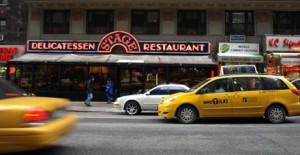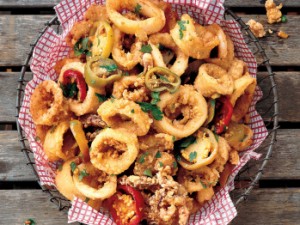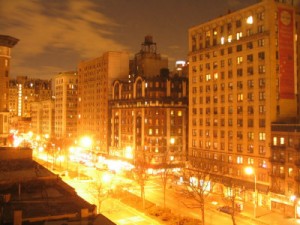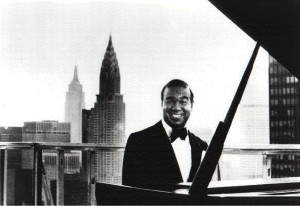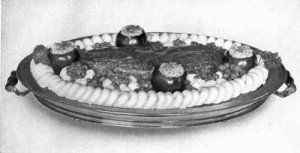HG’s favorite newspaper (and BSK’s) was the New York Herald-Tribune. Unlike the Times, it was never stodgy. And, its editors valued good writing. HG read the “Trib” (as it was familiarly called), from HG’s high school days until the paper ceased publication in 1966. Its sports page columnists, Red Smith (later with the Times) and Joe Palmer (who covered horse racing), transcended sports. Their columns were founts of wit and erudition. Later, Jimmy Breslin did a column (as did the late Dick Schaap). Homer Bigart was a great war correspondent. Walter Kerr was the drama critic. Tom Wolfe made his bow in the Trib’s Sunday Magazine, “New York”, guided by two brilliant editors, Sheldon Zalaznick (later with Forbes) and the late Clay Felker (Felker headed the group that bought ‘New York” after the Trib folded and turned it into the weekly magazine that continues to sparkle today). The hangout for Trib reporters and editors (as well as guys from the Daily News, Newsweek and Business Week) was the eccentrically named Artist and Writers Restaurant (formerly club) at 215 W. 40th. Nobody ever called it by that name. It was “Bleeck’s,” named after its proprietor. The cuisine was German (so were the waiters). The bartenders were Irish. The big activity at the bar was the “match game.” Loser in the game bought the winners drinks. The Trib’s society columnist, the gourmand-dandy-fashion plate Lucius Beebe, played the game with golden matches he kept in a special leather case. That guy had style. HG dined (and drank) at Bleeck’s many times. HG only supped on one dish, Konigsberger Klopse. This is a Prussian dish — veal-beef-pork meatballs in a lemony sour cream and caper sauce (an abundance of capers). Bleeck’s added a handful of dill to the dish and served it with boiled potatoes (or noodles) plus braised red cabbage. Mighty tasty and perfect with dark German beer. Tom Wolfe and Jimmy Breslin (both in their eighties) are alive and productive (as is HG). But, Bleeck’s, like the Trib, is long gone.
“Trib” and “Bleeck’s”
January 9th, 2013 § 0 comments § permalink
Another Heartburn Heaven Is Gone
January 5th, 2013 § 0 comments § permalink
The Stage Delicatessen (on Seventh Avenue in New York, a few blocks south of Carnegie Hall) has closed. Farewell to another heartburn heaven. Maybe it’s time to declare the Jewish delicatessen an endangered species. For many years, the Stage slid downhill, catering to tourists and the post-theater crowd. But, in its prime (during the 60’s and 70’s) it was a splendid place, a worthy successor to the Gaiety Delicatessen, the best of all Broadway area Jewish delis. The Stage was run by Max Asnas, a guy with a heavy Yiddish accent and an irreverent wit. Broadway columnists dubbed him “the Corned Beef Confucius .” A woman complained to Max: “I don’t like the looks of this whitefish.” Replied Max: “If you want pretty, order a goldfish.” Max once served lox and bagels to a rustic from Georgia. According to Max: “The Geogee boy esks: “Which is the lox and which is the bagel?'” The Stage’s rival on Seventh Avenue, the Carnegie Delicatessen, survives. Still selling overstuffed and overpriced pastrami sandwiches to tourists. Broadway Danny Rose would not feel at home.
Sad, sad, sad.
December 17th, 2012 § 0 comments § permalink
HG is downcast. Boston’s Locke-Ober, the great, venerable (in business for almost 150 years) restaurant has closed and its equipment and memorobilia are being sold. Another wonderful, gracious culinary landmark has bitten the dust. Ah, Locke-Ober. Heaven on a cold New England night. Dark wood. Old paintings. Big, comfy chairs. Soft lights in old fixtures. Professional waiters. And, the food. Oysters and clams from the New England coast, briny, cold and shucked with finesse. Old fashioned dishes like Lobster Savannah; calf’s liver with bacon and onions; broiled Boston scrod. The best gratin dauphinois this side of Paris. Perfect, crisp onion rings. A wide selection of foraged wild mushrooms. One of the few places in the United States where steak tartare was done right. And, HG’s favorite dessert, a house specialty: Indian Pudding topped with creamy vanilla ice cream. HG must stop. Eyes have become misted.
Goodbye Jewish Deli
December 2nd, 2012 § 0 comments § permalink
HG’s pal, Bill Schuck, sent him a copy of The Deli Man, a clip from a longer film. Nice nostalgic stuff about Jewish delis with cameos from Larry King, Alan Dershowitz and other pastrami fanatics. Shocking fact. There were once 1,550 Jewish delis in the five boroughs of New York. There are now only 150 in all of North America; that said many staples of the Jewish Deli (pastrami, chopped liver, etc.) have become part of the mainstream eating culture of the United States. According to informed opinion, the best Jewish deli in the United States is Langer’s, located in a gritty Los Angeles neighborhood. The proprietor of Langer’s is gloomy about the future of the deli. Jewish kids prefer hamburgers. Sad. They will never know the glory of a heartburn produced by a bowl of matzo ball soup followed by an overstuffed pastrami sandwich.
Rhode Island Calamari
December 1st, 2012 § 0 comments § permalink
Last night BSK sauteed calamari in olive oil with a heap of sauteed garlic and hot and sweet Greek-style pickled cherry peppers. HG fried some catfish filets (Dust the fish in Zatarain’s Fish Fry, dip in beaten egg, roll in panko crumbs and fry in very hot grapeseed oil). BSK stir fried some baby bok choy. Lemon wedges, Frank’s Hot Sauce, chilled Spanish rose. Big time feast. HG first encountered the calamari with peppers dish in Rhode Island, where it is a regional specialty. HG was cycling along the bike path between Riverside and Bristol some years ago. Hunger took over. HG stopped at a plain spoken little diner alongside the path. Ordered the calamari-and-pepper appetizer and a bowl of linguini with white clam sauce. The “appetizer” must have contained about two pounds of calamari and the pasta dish could have fed four hungry long distance cyclers. HG, a champion Clean Plate Ranger, met the challenge. Finished it all. HG has wanted to repeat this modest snack. The restaurant, alas, has closed. Another dismal sign that fast food chain hamburgers are diminishing local food treats.
Sandwich Hall of Fame
October 28th, 2012 § 2 comments § permalink
The Vietnamese Bahn Mi (BBQ pork, a variety of pickled and fresh vegetables, Vietnamese pate. etc. on a baguette) has become a big winner among fanciers of sandwiches and Asian food. There are are many restaurants in New York specializing in this sandwich. Causes HG to sigh. With the demise of Jewish delicatessens the Banh Mi seems slated to replace the pastrami sandwich as the New York symbolic nosh. Sad. Best sandwich ever was the pastrami, chopped liver, cole slaw, Russian dressing sandwich on seeded rye served at the demised Gitlitz Deli on Broadway and 78th. This was closely followed by the Reuben (corned beef, sauerkraut, swiss cheese, Russian dressing, rye bread — grilled to molten perfection) at Reuben’s Delicatessen (long closed) on East 58th. Runner up was the rare room temperature sliced roast beef with thinly sliced raw onion and coarse salt on rye bread liberally coated with chicken fat. HG liked this at a delicatessen on Beach 116th Street, Rockaway Park. HG also fancied the muenster cheese and lettuce sandwich on an onion roll served at long shuttered cafeterias like The Belmore and Dubrow’s. HG is not just a parochial adherent of old style Jewish sandwiches. He has always fancied Cubanos, those pork and cheese sandwiches pressed upon a hot grill served at Cuban restaurants. HG often had one (accompanied by black beans and rice) at many Washington Heights hole-in-the-wall eateries. Good stuff. Those joints also served the best steaming cups of espresso.
Young New Yorkers Living in Expensive Closets: Read This And Weep.
October 10th, 2012 § 0 comments § permalink
Some 48 years ago (seems like yesterday). HG, BSK, their two adorable children, their live-in mother’s helper and their poorly trained but decorative standard poodle, lived in a 12th floor Upper West Side apartment with dramatic views of the Hudson River and the New Jersey Palisades. A very spacious residence. Big living room. Big, separate dining room. Nice windowed kitchen and pantry. Four bedrooms and three baths (one en suite). The rent: $274 a month (later raised to $292 and a similar apartment in the same building now rents for $15,000 a month). Ah, rent control, you lovely bit of legislation (of course, obtaining this rent controlled paradise involved some bribery, chicanery and corruption). This did not shock HG, a born and bred New Yorker. In those days the Upper West Side was affordable and diverse. There was still a heavy Jewish influence. Big time theater and entertainment folks (Abe Burrows, Leonard Bernstein, Isaac Stern and many more) lived on Central Park West alongside many affluent professionals and business persons. Side streets from Central Park West to Broadway were gritty (except for W. 67th Street, site of the Des Artistes apartment house and many studios of painters and musicians). Riverside Drive and the Avenues and cross streets west of Broadway were filled with intellectuals and creative types who had more brains and talent than money. Forget Greenwich Village. The Upper West Side was the home of professors, critics, novelists, dancers, journalists, composers, actors, musicians and school teachers. Lots of European intellectuals who had fled Hitler and many Holocaust survivors (the little, pale, Nobel Prize winning writer, Isaac Baashevis Singer, who lived on W. 86th Street, often wrote about them). The Heresford (West Side apartment houses often had British names, a touch of Anglophile class) where HG and BSK lived, had much artistic ferment. Among its residents were Peter Boyle (before Hollywood and TV fame); film composer Michael Small, the critic and editor Ted Solotaroff; Gary Null, the health and sex writer, guru and radio personality. There were also some Broadway dancers, the cantor of a major synagogue and lesser artistic lights. The Upper West Side was filled with movie theaters showing art films (the New Yorker, Thalia and Symphony) and plus the first run houses (Loew’s 83rd, the Beacon,etc.). Food was a neighborhood obsession. Zabar’s, of course, but also Murray’s (preferred by some smoked fish aficionados) and Barney Greengrass (unsurpassed sturgeon). Middle European restaurants like Eclair and dairy restaurants like Steinberg’s and Paramount. Gitlitz’ Delicatessen on Broadway and 78th ( much superior in HG’s informed opinion, to Katz’s, Carnegie or 2nd Avenue Deli). The jewel of the West Side was the Tip Toe Inn (on Broadway near 86th Street). A huge place with a huge menu. Everything was delicious and inexpensive (the New York Public Library has a nice collection of old menus….Here’s a link to Tip Toe’s 1954 menu. Be astonished). There was a rotisserie in the Bretton Woods Hotel (86th and Broadway) that barbecued ducks and chickens. Sunday dinners for HG and BSK often featured one of those juicy, crisp skinned ducks and an avocado-sweet onion-sliced orange salad. Chinese restaurants were clustered around Broadway and 96th and they were very good (the first Szechuan restaurant in New York was on Broadway and 95th). There were also some Cuban/Chinese places where you could get good shrimp dishes plus Moros y Cristianos (black beans and rice) Fairway didn’t exist but for those who liked to eat at home there were butchers like Endicottt Meats and Nevada Market (where you could get some exotic stuff including bear, in season). Good bakeries. Mom and Pop greengrocers. Citarella’s for fish. Broadway Nut Shop for sweets. Daitch Dairy (79th and Broadway) for tub butter and cheese. Bretton Wood Rotisserie for barbecued ducks. HG and BSK were not plutocrats but could afford all of these good things. Yes, the Upper West Side had lots of junkies, hookers, muggers and burglars. Their presence made West Siders feel superior to residents of the antiseptic Upper East Side. Now, let HG make you young folks really jealous. HG, BSK and family spent all summer plus spring and fall weekends at their Fire Island home. Built atop a dune it had panoramic views of the Atlantic Ocean and Great South Bay sunsets. The family bought it for $40.000. HG’s first Fire Island house (in 1959) cost $4,000 ($1,000 for land and $3,000 for two bedrooms, bathroom, kitchen, living room and deck). In 1960, HG added two more bedrooms, another bathroom and additional decking. Cost: $2,000. That’s right. The numbers for these Fire Island properties are correct. Read and weep.
Going, Going, Gone.
October 9th, 2012 § 0 comments § permalink
Bobby Short and Mabel Mercer are in the Great Golden Cabaret In Heaven. Two New York perennial cabaret venues — Oak Room at the Algonquin and Feinstein’s at the Regency — are closed or about to close. That leaves only the Cafe Carlyle as the last of the sophisticated New York supper clubs. These supper clubs were where the voices and songs of Mabel Mercer, Cole Porter, Rodgers & Hart, Harold Arlen and Noel Coward were idolized and celebrated. Where once hip folks of all ages went to those uptown Supper Clubs, the patrons now are increasingly ROF’s (Rich Old Fogeys) — obviously, a diminishing market. According to reports, the supper club scene in New York has shifted downtown with an emphasis on irreverence, drag and transgender performers. In this age of pornographic saturation, the old fashioned, bittersweet, romantic lyric seems a bit old fashioned. During the 50’s and 60’s there were scores of supper clubs in mid-Manhattan. Nelly Lutcher sang earthy tunes. Ted Straeter exemplified world weary sophistication. Spivy (a one name performer like “Hildegarde” and “Liberace”) and Dwight Fiske were queen and king of the double entendre (very tame stuff compared to much of today’s music and stand-up comedy ). HG’s favorite was Laurie Brewis who held forth at the Hotel Earle on Waverly Place in Greenwich Village.
During the 50’s, a date night for HG often consisted of martinis at Jack Delaney’s bar, big platters of seafood paella and a pitcher of sangria at one of the Village’s many good Spanish restaurants, a European movie at the Art movie theater — and then on to Brewis and Earle at midnight. The New Yorker Magazine described Laurie Brewis as “a fey bistro version of Noel Coward,” “The London Edition of the Show Business Encyclopedia” and a “bouncing Englishman playing his London portfolio and bringing back the tunes that everyone but he has forgotten” Laurie Brewis and his Piano. HG, his snifter of cognac, his Marlboro cigarette, his shapely female companion of the evening. Pleasant memories. Needless to say, HG always wore a shirt, tie, well pressed suit and shined shoes during these revels. One dressed to dine and date. Jeans were apparel for plumbers and cowhands.
Big Meal on Wood
September 10th, 2012 § 0 comments § permalink
Many foreign gourmands have commented, unfavorably, on the tremendous size of American restaurant portions. They infer that this contributes to the tremendous size of Americans. HG believes that a reliance on snacks and sugary drinks is a bigger contributor. But, HG does admit restaurant portions in the U.S.A. are too large. HG feels light, sprightly and well fed after a Paris lunch where the portions are small and the fat content is large. A U.S.A. lunch can give HG leaden feet and a heavy head. There is big and then there is really big and into that category falls a dish that used to be served in the fancier restaurants of HG’s youth. This was planked steak (usually served in a portion meant for two but could feed eight at a Paris bistro). Here’s how the dish was constructed: A very big steak was centered on a very big plank of wood (basically a cutting board). It was surrounded by every seasonal vegetable –spinach, broccoli, asparagus, beets, carrots, peas, zucchini. The steak got a big blast of buttery steak sauce and the vegetables glistened with additional butter. Piped around the entire border of the plank and creating a picturesque frame for the meat and vegetables were mashed potatoes mixed with abundant butter and heavy cream and then browned under the broiler for a brief moment. Planked steak was a very nice All-American dish that paid for the college education of the chidlren of cardiologists.
What Happened to ???
September 8th, 2012 § 2 comments § permalink
Some great dishes seem to have disappeared from restaurant menus. Mozzarella in Carozzo, a delicious fried mozzarella and bread confection (often enhanced by anchovy sauce) is gone from Italian restaurants in New York. Hard to find clams casino or clams oreganato. Pork chops with vinegar peppers was a staple at the late, lamented Delsomma and other Italian eateries. Gone except for venerable Patsy’s on West 56th. HG misses boeuf bourginoun and plain, old American beef stew. What could be better on a cold day (with a big dollop of buttery mashed potatoes or egg noodles) ? Ditto really good meat loaf, which, except for the dish’s re-invention at many a New York hot spot, has gone the way of a 25 cent cup of coffee. HG sees $40-$45 veal chops on menus. Fuhgeddabout it !! HG wants those hearty, bargain treats.

